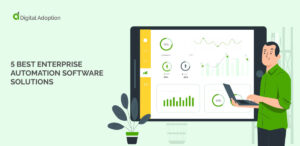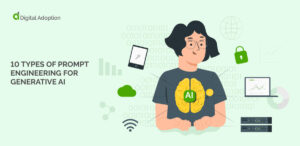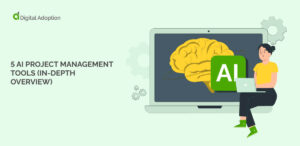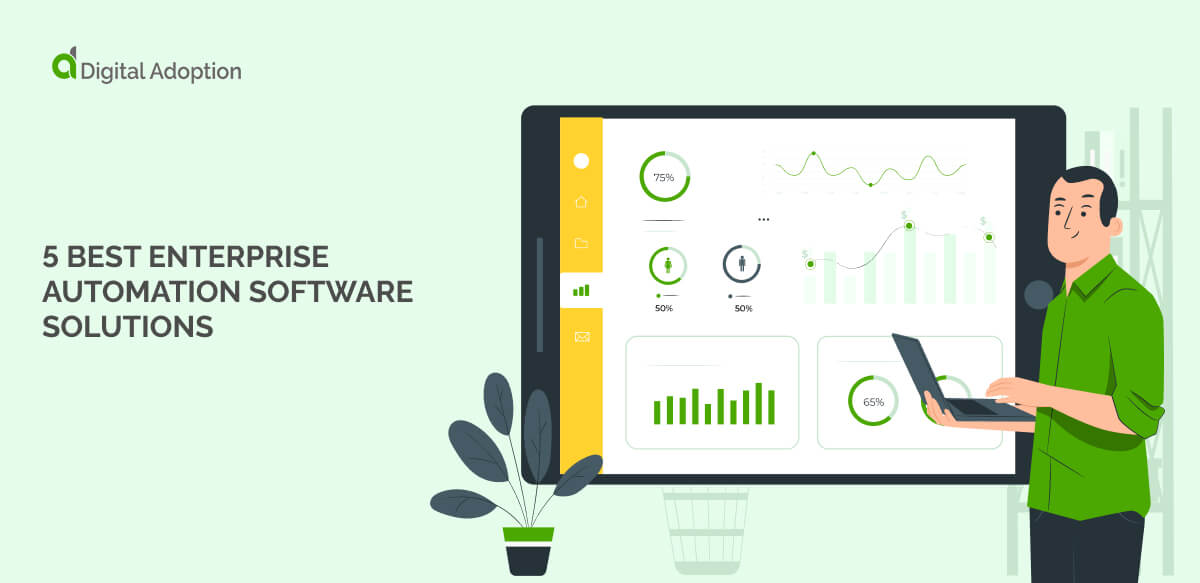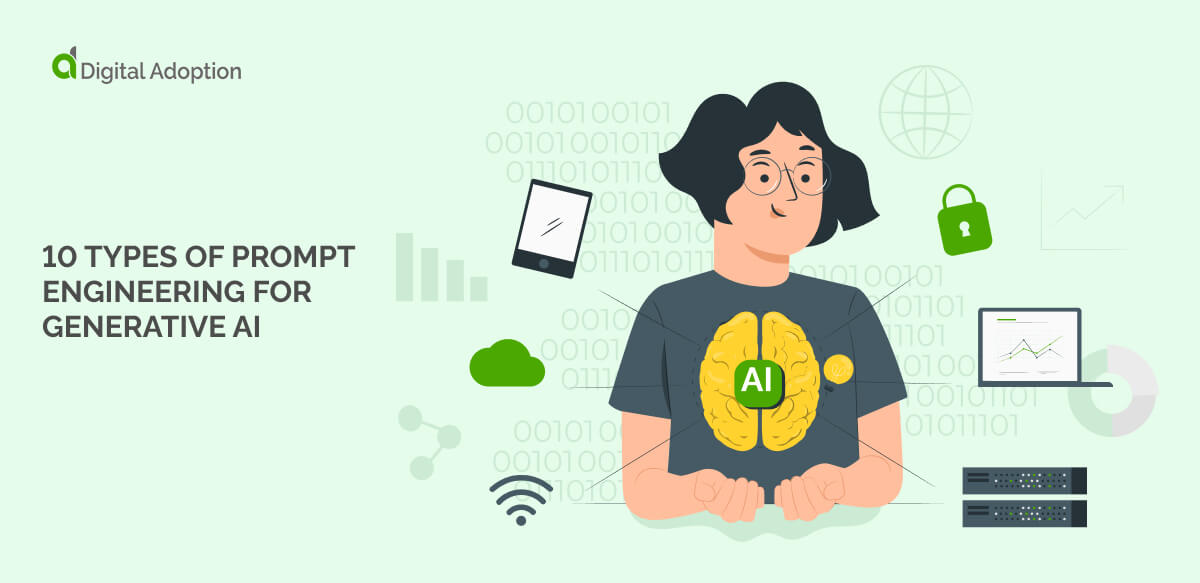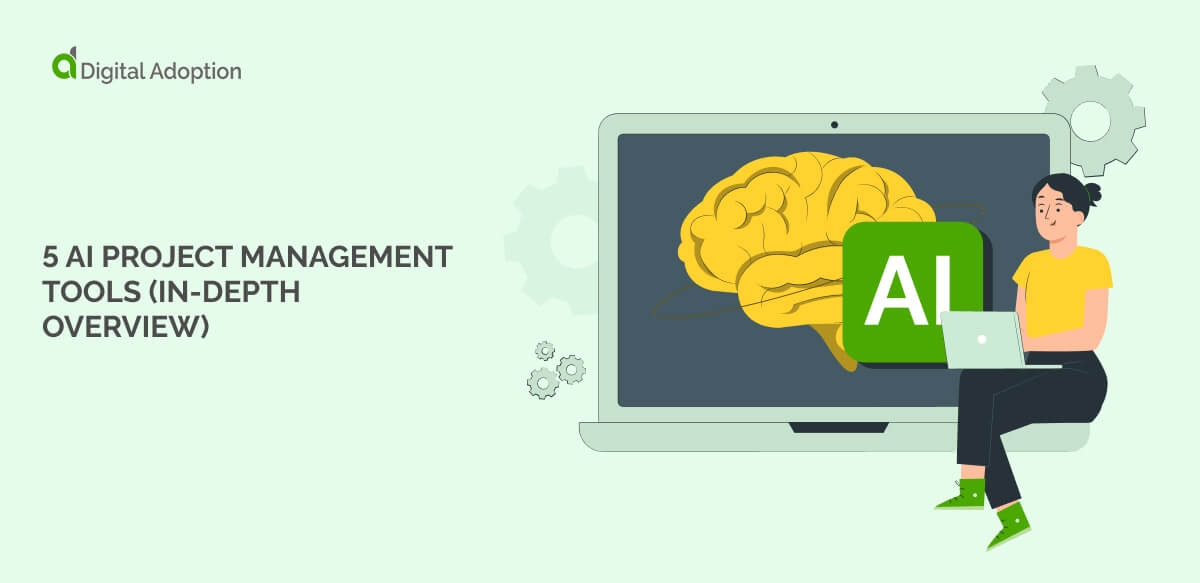Software companies release new iterations of existing software every day, as well as software featuring brand new functions to deal with the changing face of business. It’s impossible not to get overwhelmed by having to learn so many new tools every year.
Short on time? Read our digital adoption platform comparison guide.
Training staff to use new software manually would be inefficient and resource-heavy. Luckily there is an accessible, low-cost answer allowing staff to learn while working; a digital adoption solution (DAS).
But what exactly are they, and what makes digital adoption solutions important? How do you identify the right one for your staff and organization? And what is a digital adoption platform (DAP)? We can discover the answer to all these queries in depth by looking at DASs.
- What is Digital Adoption?
- What Is A Digital Adoption Solution?
- Are Companies Spending Enough to Train Their Employees Digitally?
- How Do You Measure The Success Of A Digital Adoption Solution?
- 10 Benefits of Digital Adoption Solutions
- How Are Digital Adoption Solutions Essential For In-app Training Solutions?
- What Are The Best Digital Adoption Solutions For Your Organization?
- Features of an effective digital adoption solution
- What Is The Future of Digital Adoption Solutions?
- Why Choose A Digital Adoption Solution?
What is Digital Adoption?
Digital adoption integrates new technology into business processes to augment existing or enable new ones. This process involves technology adoption by planning what is needed, researching the right software or other technology, and purchasing it via license for multiple users.
Another issue arises when the technology arrives on the individual staff systems: user adoption. It takes time to learn how to understand and use new software, so any way to make the process more user-friendly saves vast amounts of resources. This stage is where digital adoption solutions come in, allowing multiple applications to be used, guided, and explained on one digital adoption platform, lowering support costs.
Digital Adoption Platforms Vs. Digital Adoption Solutions
The difference between a digital adoption platform and a digital adoption solution comes from preference. Gartner names them digital adoption platforms, while WalkMe and many other organizations refer to them as digital adoption solutions. Both mean the same thing. So let’s get into the details of precisely what a DAS is.
What Is A Digital Adoption Solution?
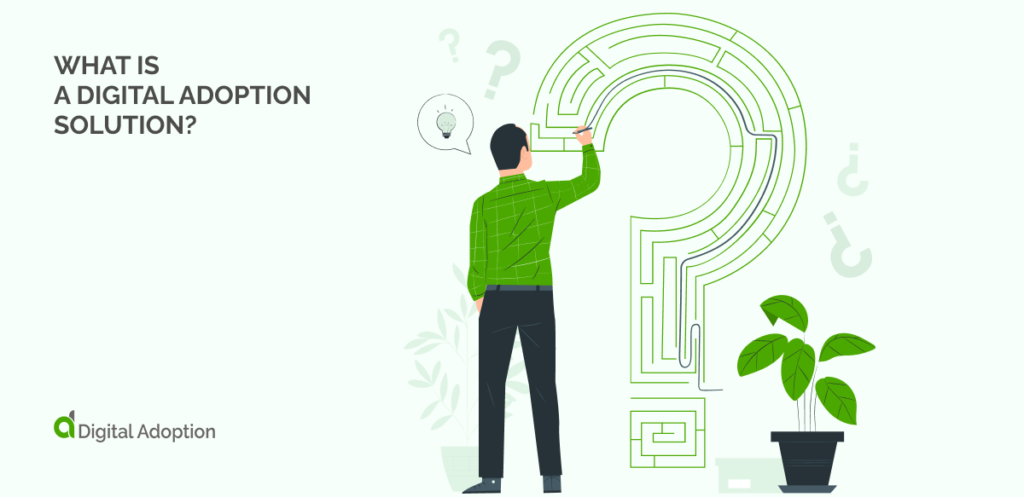
To define digital adoption solutions, we must first consider the issues they resolve. Today, technology adoption is at the forefront of any organization’s priorities, meaning that staff can feel constantly inundated with the responsibility to learn new software adoption solutions.
Organizations cannot afford to avoid this process, so a solution needs to be devised to support staff deal with these technological changes. But why is there such a need for digital adoption, digital transformation, and the resulting DASs?
Background To Digital Adoption Solutions
There are three key concepts to consider when we think about DASs: digital transformation, digital adoption, and finally, DASs. Digital transformation comes first as this is the need for change, leveraging new technology for market resilience. Secondly, digital adoption represents the act of staff adopting the technology provided as a result of an organization’s digital transformation. DASs are third as they streamline the adoption process to give a smooth and effective transformation.
When Are Digital Adoption Solutions Needed?
The three concepts described above help organizations remain resilient against many other factors. We have split these factors into categories of need for change which all feed into the requirement for DASs:-
Crises – DASs are at the heart of supporting staff dealing with the new technology involved in reacting positively and innovatively to crises such as pandemics. Crises such as the Covid-19 pandemic showed the world which companies can thrive in a crisis and which fall flat. The companies which thrived could change in a methodical, cost-friendly way where needed.
Pressure – Organizations are successful when they have a proactive attitude toward internal and external pressures. Negative PR is one example of external pressure. When the taxi company Uber attracted negative media attention, it tailored its response accordingly, remaining resilient to media pressure. DASs can support staff to alter their use of software when pressures mean organizations have to change.
New technology – Technology is at the heart of every aspect of business today, and user onboarding is a large part of this. Researching and investing in current technologies, such as AI, cloud transformation, and machine learning, is essential for any organization to remain sustainable.
These technologies are useless if staff cannot use them, so investment in and updated research into the latest DASs is also essential to optimize new technology. Snapchat is an example of a technologically basic app that saw that smartphone camera technology would increase over time, increasing its daily users from 32 million in 2014 to over ten times that figure in 2022.
Mergers and acquisitions – Staff often become anxious during mergers and acquisitions because they are not always successful due to the other three factors leading to collapse. Disney and Pixar held their own vastly different cultures, but strong leadership made their merger successful. AOL and Time Warner split after problems such as under-performance led to losses caused by the merger.
DASs can unify teams during mergers and acquisitions, as all new or existing staff use the same DAS software to navigate the different software they use.
Digital adoption creates the backdrop for why organizations need DASs, so let’s look at this concept in more detail.
Are Companies Spending Enough to Train Their Employees Digitally?
A yearly investment survey conducted by the European Investment Bank across Europe reveals that while firms have increased their investments into new digital products, their expenditure on training employees to use that software has decreased. The survey covers 13,500 firms and has been administered since 2016.
This survey reveals a troubling trend in many European businesses: while they are investing more heavily in creating new digital products, they are emphasizing less on training their employees to use that technology. Over the past few years, we have seen a steady increase in investments in digital products like software, apps, and websites. However, at the same time, many firms have been decreasing their spending on training employees to use these new tools effectively.
This is concerning for several reasons. It suggests that businesses are not making the most of their investment in digital technology, as they cannot fully utilize these products’ capabilities. It also suggests that they are putting short-term considerations ahead of long-term growth, as they neglect to invest in their employees’ skills development.
If we want European businesses to thrive in the increasingly competitive digital economy, we must find a way to encourage them to invest more in employee training. This could involve providing incentives or subsidies for firms that prioritize skills development or establishing partnerships between businesses and educational institutions to increase access to quality training programs.
According to the survey, the share of firms that introduced new products and processes to their companies increased to 26-27% in 2019-20 from 22% earlier. The percentage of firms that innovated in their products, processes, and services improved from 32-34% to 35-41% post-2019.
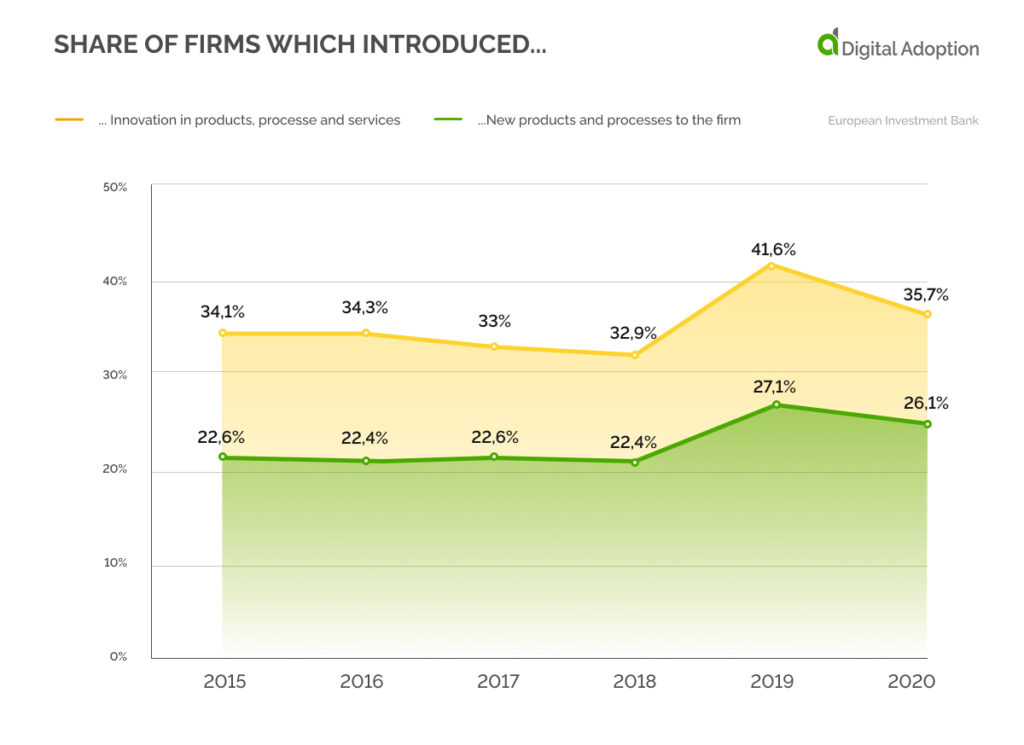
However, the share of investment in the training of employees declined from 10.4% to 9.4-9.6% in the corresponding period. At the same time, spending on software data and IT networks increased from 12-13% to over 15%.
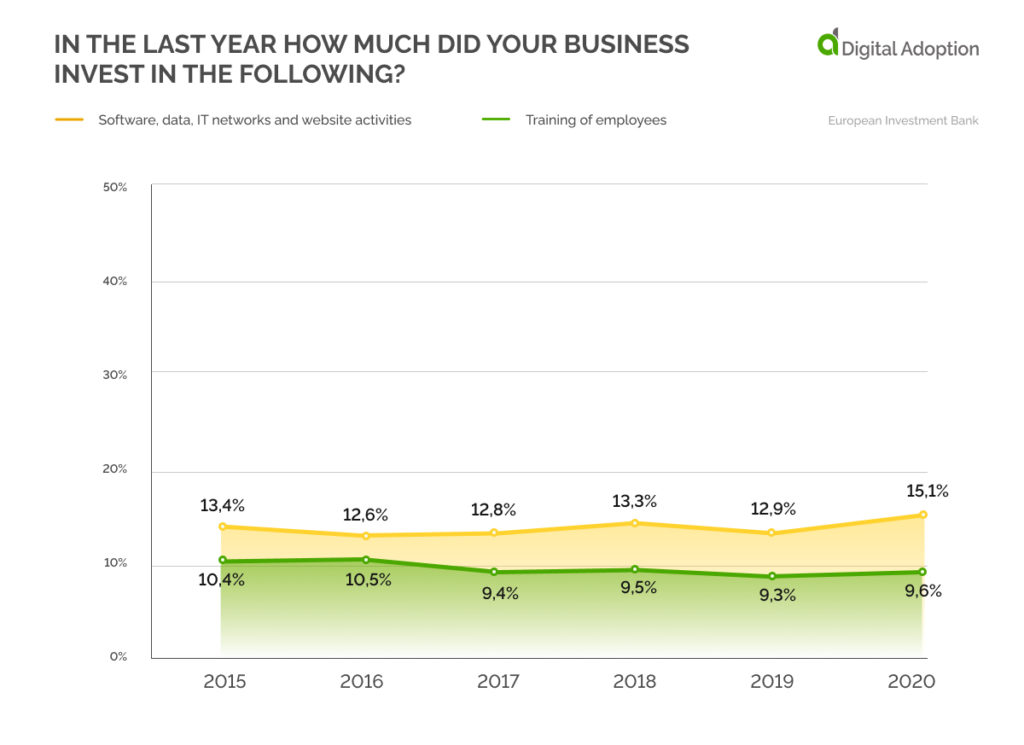
So, despite significant improvement in the number of firms that invested in digital products and innovation, the companies in the European Union reduced their share in employee training. This highlights the importance of Digital Adoption Solutions, which provide an accessible, low-cost way to train the staff and equip them for the changing needs.
How Do You Measure The Success Of A Digital Adoption Solution?
Digital adoption can save a company when achieved successfully or break a company if conducted inefficiently. Inefficiency is what digital adoption solutions seek to resolve but can also create massive frustration when carried out ineffectively, leading to far more waste. So how do we make sure DASs solve more problems than they create?
Establish goals
- Before embarking on your digital transformation journey, write down the goals you need the adoption solution to achieve.
- What do you need to achieve by the end of the digital adoption solution strategy?
- Having a clear destination allows for a smooth DAS journey.
Define KPIs
- What journey will this KPI take us on to achieve our overall goals?
- Zooming in on a few metrics that align with your goals can help you maintain focus on success.
- With each KPI, always note down a reason.
User analytics
- You need the right tools for the job; in this case, you need to ask yourself and your team what data we will analyze to ensure we have achieved our KPIs.
- Will data be experience-based or number-based?
- How often do we need to check analytics?
- A detailed plan is needed of not just how to generate the data but how to analyze it for optimal outcomes.
Forming a plan is essential to getting the most out of any DAS. Without planning, any DAS will result in frustration, wasted resources, and, in worst cases, significant structural weaknesses for your organization.
10 Benefits of Digital Adoption Solutions
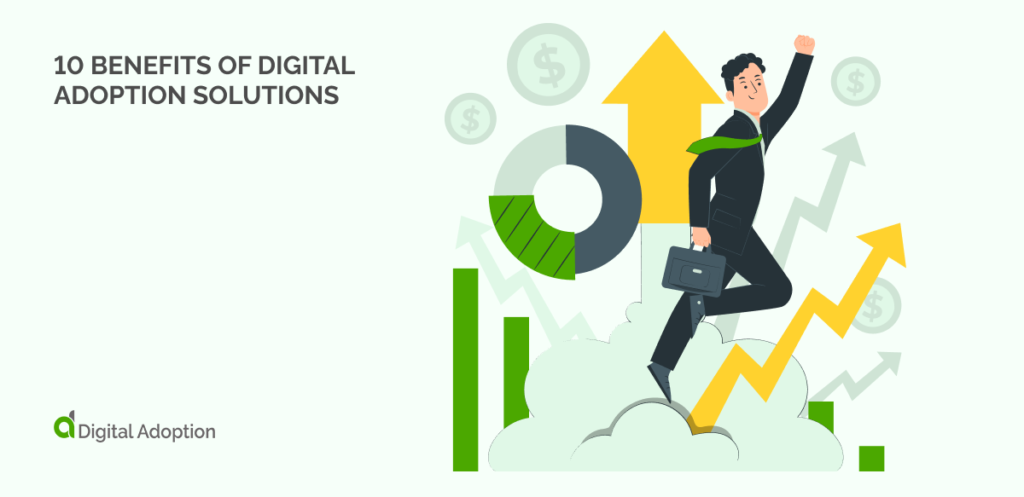
There are several benefits to using a DAS. Here are the ten most important DAS advantages:-
- Automate training solutions – Staff can use in-app guidance to automatically acquire information when needed. Salesforce users can achieve complex workflows by following a series of instructions on a DAS for automated tasks.
- Improve the user experience – Digital adoption solutions offer guidance to simplify the experience of using complex software without the need for human intervention. Users maintain their focus on tasks while improving employee engagement levels due to the decreased frustration of learning to use new tools. DASs reduce user onboarding time for both customers and staff.
- Decrease technical support costs – Technical support calls can increase costs, both financial costs to the organization and the cost to the end users. Reducing technical support calls allows users to become more productive and autonomous, boosting engagement, confidence, and motivation.
- Accelerate onboarding, training, and adoption programs – Faster time-to-competency translates into shorter time-to-ROI. With digital adoption solutions’ in-app guidance, they learn software more quickly, helping organizations reap the rewards of their investment in less time. Staff can achieve the customer onboarding process quicker, improving customer experience. User engagement can boost productivity by engaging with ongoing training goals.
- Improve employee productivity and motivation – Overall proficiency levels go up, which then boosts productivity levels. Organizations can prevent employee skill levels from stagnating by using digital adoption solutions to promote specific software features.
- Increase software utilization – The more capabilities that workers use, the more value is delivered. Full software adoption means maximum effectiveness and efficiency from its use. DAS allows better software implementation improving user adoption rates.
- Improve the bottom-line ROI of a software platform – Ultimately, digital adoption solutions help businesses extract more value from their software investments and workforce.
- Knowledge retention – Knowledge is the information specific to a company and the experience of staff, both of which are costly to generate over long periods. DASs increase software adoption and improve experience management for staff, making frustration decline and satisfaction increase. Using a DAS can improve staff retention and avoid lost company knowledge and experience complications. Staff continues working for a company where they understand and see value in their software.
- Improve sales enablement – DAS offers significant benefits to sales enablement when sales teams can utilize software tools to the optimal level. DAS can speed up employee performance, resulting in more inbound and outbound leads, improving company profits
- Optimize customer retention – Customers are more likely to return when they understand a company’s products through excellent DAS implementation.
We can view DAS as the lubrication needed to get the wheels of digital adoption moving toward the destination of digital transformation. Once you see the above features in the features list for a DAS, you will know it will be an effective tool for your organization.
How Are Digital Adoption Solutions Essential For In-app Training Solutions?
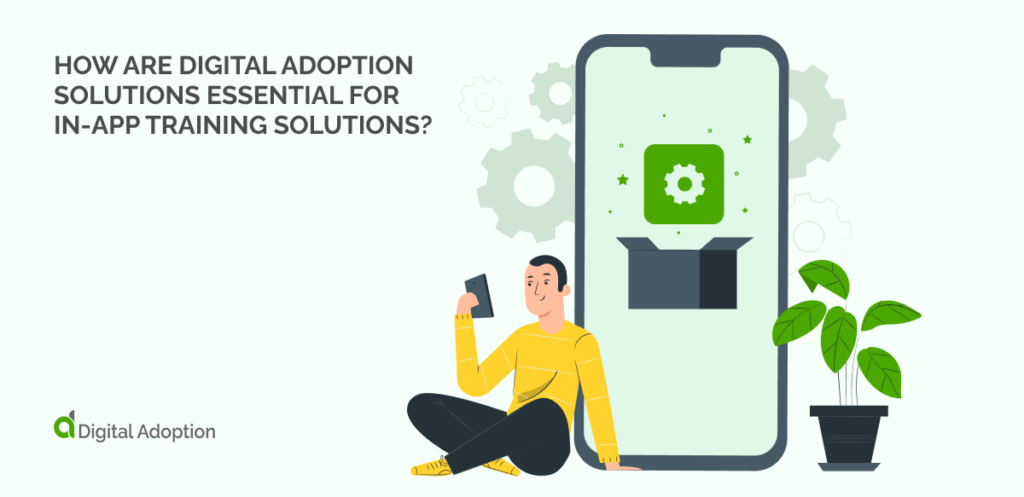
Whenever you install a new app, do you notice the information balloons that pop up the first time you use it? These balloons are part of a built-in digital adoption solution for mobile app users, as it is part of the app that shows you how to use it, giving you the most consistent user experience.
For most apps, these balloons only pop up on the first use of specific features. For customer success to translate into company success, an organization needs to transform customers from regular users into power users or advocates. However, product adoption will not occur if customers cannot use a product or service and in-app training is the perfect product adoption solution to achieving customer retention.
Think of it this way. The customer onboarding process is where you add them to a list. But the in-app training is where you take time to get to know them and form a professional relationship, so they understand what your organization offers and what they will get from the relationship. This stage is where organization establishes loyalty between themselves and the customer, achieving customer retention.
Advocate users invest personally in the organization via the app they use to access services or products. Advocates use word of mouth, social media, and positive online reviews to encourage others to convert to their favorite company or service, providing free marketing for organizations. This stage is where in-app training is critical, as it’s an app’s deeper secondary or tertiary functions that turn users into advocates.
Employee onboarding is just as important as customer onboarding, as everyone goes through the process of being convinced that a product or service is valuable. Employees know they have to register for new software adoption. But the a-ha moment will come when they see what a new piece of software is capable of when they learn the deeper features at their own pace.
Organizations can go one step further and have software tailor-made for either staff, customers, or both for any new app. A custom DAS allows detailed, in-depth instructions on how to use the app to increase user efficiency. In turn, in-app training solutions using DAS allow staff and customer success to improve when accessing the services of an organization.
What Are The Best Digital Adoption Solutions For Your Organization?
You have established that it’s essential to invest in a DAS. But which are the best digital adoption solutions for the money and the benefit of your organization? Ask yourself several questions before investing in DAS SaaS or enterprise software.
- For whom is the DAS intended, customer or staff?
- What kind of organization are we?
- What do we want to achieve with the DAS?
- On what type of platform is the DAS likely to be used?
Answering these questions will allow a CEO to decide which DAS is best for their organization. There are several DASs, so ensuring that investment is optimized with the best digital adoption solutions available is important.
Features of an effective digital adoption solution
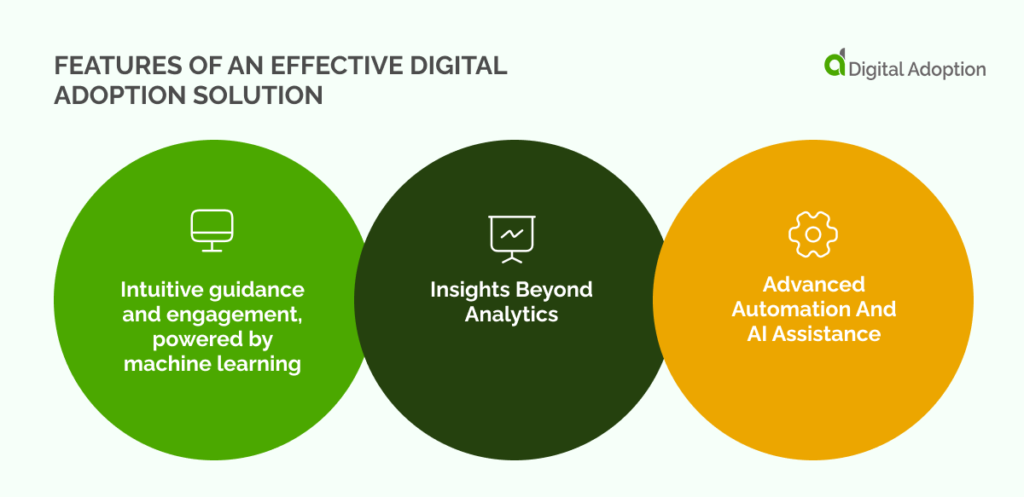
Despite Gartner only recently recognizing the digital adoption solutions category, the tools have been developing since WalkMe pioneered the first DAP nearly a decade ago.
While there are now many providers of digital adoption solutions, as listed by Gartner, enterprises should take great care in selecting a tool to meet their needs.
Here are three features your digital adoption solution should include:
- Intuitive guidance and engagement, powered by machine learning
First and foremost, when you ask yourself, “what is a digital adoption solution,” the answer should be a digital trainer. Your digital adoption solution should simplify online processes by providing step-by-step in-app guidance.
Your digital adoption solution should guide users through any process, just like a GPS. Users will immediately be able to complete complex tasks without any traditional training whatsoever. They follow the series of interactive guidance balloons. It eliminates the need for additional training in response to system updates or new features.
Digital adoption solutions are the next evolution in training methods, which deliver poor ROI due to the Ebbinghaus forgetting curve.
Your digital adoption solution should use advanced AI and contextual awareness to engage with users at the right time.
Instead of a user needing to search for help, they are proactively engaged with relevant content based on their location, time, system, predicted behavior, and even based on their interaction with the software.
Another great feature is being able to notify users of relevant news or changes within the application; you can even have messages appear on their computer desktop.
- Insights Beyond Analytics
What is a digital adoption solution? Well, a great one is a data analyst. A digital adoption solution should help you understand how to drive transformational change by providing powerful adoption insights, not just user analytics.
Senior staff can track every user’s behavior with the flick of a switch. This feature allows them to monitor the adoption of crucial processes over time. You’ll be able to find out where users struggle, what features are underutilized, and where inefficiencies exist.
Powerful AI helps you to discover behaviors that lead to mistakes and wasted time. The leading digital adoption solutions even allow you to watch real user session videos.
- Advanced Automation And AI Assistance
And finally, what is a digital adoption solution? It’s a robotic assistant.
Robotic Process Automation, or RPA, is when an automated process operates systems instead of humans. This process is a powerful way of managing a digital adoption solution because it saves resources and allows staff members to learn a system by using it for business processes, increasing output.
Attended RPA is essentially a robot that learns from the user’s actions and can suggest the following steps based on those actions to the user. Your digital adoption solution should simplify the user experience and boost productivity by eliminating tedious and complex tasks for both the front-end employee and the back-office.
How Automation And AI work
Your digital adoption solution’s insights should discover process inefficiencies; you click record and capture those processes from end-to-end, and there is an automated process in minutes. Imagine a world where employees no longer have to grapple with tedious admin tasks. No more flawed data entry and everyone can use their digital tools confidently and effectively — this is all possible with the right digital adoption solution.
What Is The Future of Digital Adoption Solutions?
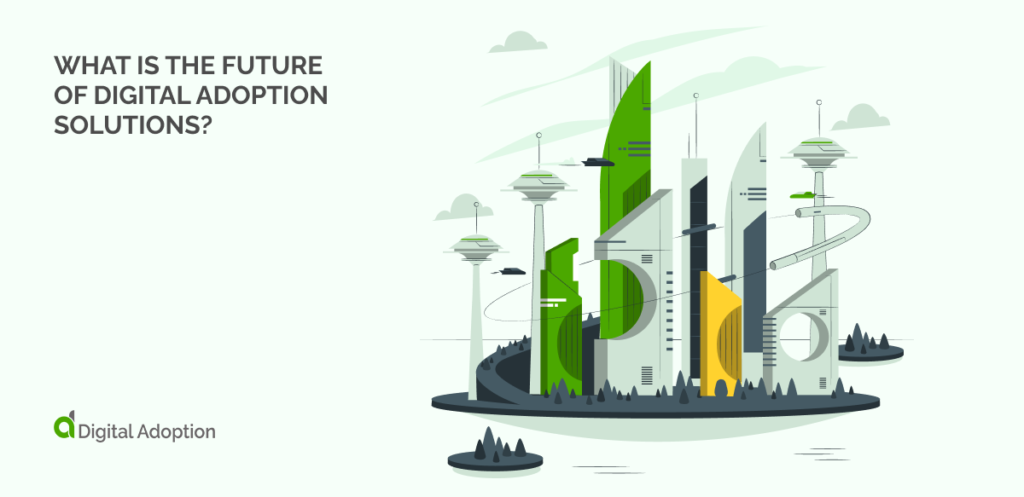
The core of digital adoption is to be agile and for organizations to use technology to evolve and adapt to changing consumer needs. So what does the future hold for digital adoption solutions?
Omnichannel Solutions: The 2030 Vision
Since the Covid-19 pandemic, digital adoption of consumers increased steeply in the online retail market as they perceived significant health and safety benefits to shopping online. However, when the pandemic eased, consumers did not return to shops in the same numbers as before the pandemic.
McKinsey suggests that a 2030 vision of an omnichannel approach is best to optimize the experience management for maximum customer success in physical retail outlets. McKinsey user analytics showed that 30-40% of cosmetics in Asia are purchased online, with such statistics helping to understand user behavior further.
The suggestion is that organizations engage in omnichannel solutions by combining physical and technology adoption, such as social media integrated within stores and fewer stores of larger size, with flagship stores being a more common sight.
Sephora is one of the frontrunners for omnichannel experiences, with a beauty app that can not only show what products are in stock online and in physical stores but shows using the smartphone camera what a product would look like on the user. By doing this, Sephora personalizes the experience for the user.
Omnichannel solutions will involve using new technology adoption solutions for staff in organizations requiring new features of DAPs to assist staff in understanding these new technologies.
Why Choose A Digital Adoption Solution?
The question is less about why to choose digital adoption solutions and more about not utilizing them. The need for digital adoption has been developing over several decades in different forms and is now more crucial than ever. Technology adoption is a massive part of an organization’s ability to be agile, competitive, and sustainable, and digital adoption solutions form the core of this concept.
Staff needs to understand and use new technology quickly, and DAPs are a perfect solution to this challenge. DAPs cut to the heart of digital adoption, offering a seamless way for staff to adopt digital solutions without thinking about it. DAPs allow staff members to use multiple applications within one piece of software to guide them on the best ways to optimize their experience and output.
The result of DAPs is that companies continue to increase revenue through technology adoption in a constantly evolving and efficient manner. This reason embodies why digital adoption solutions such as DAPs are essential in today’s rapidly changing market.




